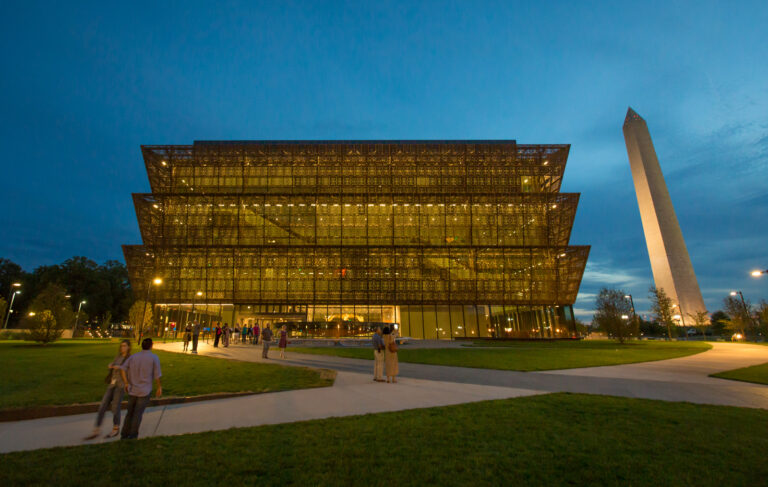Executive Actions Aim To Reshape America’s Cultural Institutions
As the Trump administration seeks to redirect museum and arts organizations, Berkeley academics assess the impact of pulled funding and new directives.

On March 27, President Trump signed “Restoring Truth and Sanity to American History,” a directive mandating that the Smithsonian Institution and the Department of the Interior, which oversees national monuments, memorials and statues, rectify “divisive narratives that distort our shared history.” This is just one of several actions aimed at changing how arts and humanities organizations tell the story of the country’s past and present. For instance, the majority of staff at the Institute of Museum and Library Services and the National Endowment for the Humanities has been put on leave or terminated, and Trump installed himself as the Kennedy Center’s chair of the board of trustees and announced plans to shake up the prominent arts organization.
This reframing of the nation’s history has been welcomed by Trump’s supporters but has prompted concern from organizations like the American Historical Association and high-profile artist cancellations at the Kennedy Center. Given the outcry, UC Berkeley News asked experts from various campus departments to reflect on why politicians might have a vested interest in influencing such cultural institutions and what the impact of these changes might be.
Shannon Jackson, chair of the History of Art Department and one of the principal investigators on a Mellon Foundation grant about arts censorship, on government influence on cultural institutions:

There are many reasons why the arts and culture, like education, have become targets. The cultural sector serves many functions for a democratic society: The arts can offer spaces of community connection and healing, and they can also offer spaces of critical reflection and speculative imagination. Precisely because so-called “soft power” is real power, autocratic leaders want to keep “culture” in check. Under the guise of efficiency, authoritarian governments eliminate some wings of their national cultural apparatus and appropriate others for their own ends.
In many countries around the world, nations support a robust cultural sector that is accessible to all. That support does not mean limiting and censoring the ideas that come out of it. Democratic countries do not censor and redirect “culture” so that it can become a marketing campaign for a national administration; that is what autocratic countries do. That is certainly what fascist countries do, as the historical lessons around “degenerate” art in Nazi Germany should teach us.
Tyler Leeds, a sociology Ph.D. student researching the theoretical underpinnings of the 1619 Project, a New York Times report on how the institution of slavery shaped the U.S. that Trump has similarly criticized as a “crusade against American history”:

The right is characterizing these moves as a return to “sanity,” a framing that casts their vision for cultural institutions as commonsense. And although their supporters may share in this vision, it is largely shaped by the conservative elites who locate and direct the battlefronts of the culture wars. As I show in my research on the backlash to the 1619 Project, Republican politicians and Fox News hosts used their massive platforms to conjure opposition to historical scholarship on racism. The political gains for this strategy for the right are massive, as cultural wins are easy to notch and are felt as real wins on the ground, even though they offer nothing to voters who need better jobs, health care and housing.
Daniel J. Sargent, an associate professor of history and public policy, on the executive order and political applications of history:

Donald Trump’s executive order, “Restoring Truth and Sanity to American History,” thrusts the federal government into disputes over a supposed “revisionist movement” in American historiography. Whether the American past should be interpreted as a story of systemic oppression, or as one of progress toward equality, remains an open and necessary debate. President Trump might be cautious about trying to resolve such debates by fiat. Disagreement is central to the historical enterprise, from which the government benefits. The federal government is the nation’s largest employer of history Ph.D.s, and executive agencies maintain virtual departments of historians. Public policy gains from their open and contested interpretations of the past. If the past is a laboratory of experience, insisting on a single interpretive framework — whether celebratory or relentlessly critical — limits our capacity to learn. President Trump should appreciate the point. After all, mainstream economists long denounced tariffs as a constraint on growth, often citing the post-1945 era. Yet,Trump has staked his presidency on the idea that tariffs can reignite prosperity — on historical revisionism, that is.
John Connelly, 2024 Guggenheim fellow and history professor who studies Eastern and Central Europe and teaches a course about fascism, on parallels to the past:

Every fascist or right-wing authoritarian regime does all that it can to shape the historical narrative in ways it finds acceptable. It engages in what we would call cultural wars and uses all means at its disposal, first exhausting legal means, then going beyond, especially if it encounters no resistance. But note the current regime will find lots of support because many Americans bristle at the notion that there is something inherently wrong with patriotism, which seemed to be a suggestion in some of the exhibitions referred to in the [executive order].
Another relevant issue is fear: fear that writing or saying the “wrong” thing about the past can have consequences for [Smithsonian or Department of the Interior staff members’] material security. Anticipating what seems opportune to say and even think about a subject is poisonous for work in history, which ideally seeks truth.
